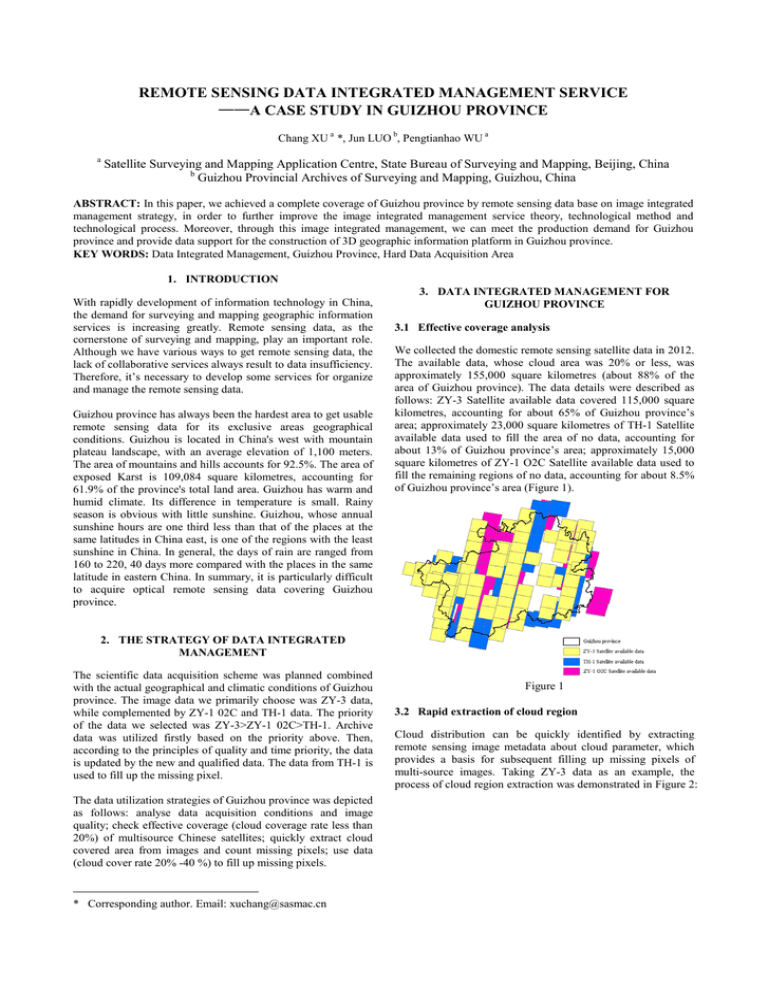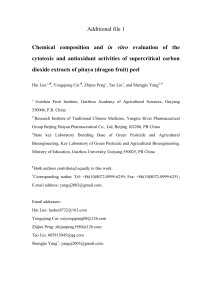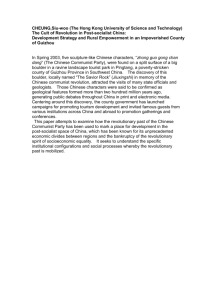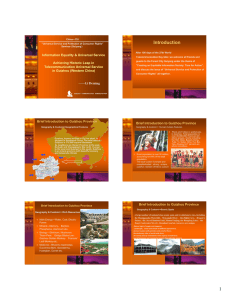REMOTE SENSING DATA INTEGRATED MANAGEMENT SERVICE
advertisement

REMOTE SENSING DATA INTEGRATED MANAGEMENT SERVICE ——A CASE STUDY IN GUIZHOU PROVINCE Chang XU a *, Jun LUO b, Pengtianhao WU a a Satellite Surveying and Mapping Application Centre, State Bureau of Surveying and Mapping, Beijing, China b Guizhou Provincial Archives of Surveying and Mapping, Guizhou, China ABSTRACT: In this paper, we achieved a complete coverage of Guizhou province by remote sensing data base on image integrated management strategy, in order to further improve the image integrated management service theory, technological method and technological process. Moreover, through this image integrated management, we can meet the production demand for Guizhou province and provide data support for the construction of 3D geographic information platform in Guizhou province. KEY WORDS: Data Integrated Management, Guizhou Province, Hard Data Acquisition Area 1. INTRODUCTION With rapidly development of information technology in China, the demand for surveying and mapping geographic information services is increasing greatly. Remote sensing data, as the cornerstone of surveying and mapping, play an important role. Although we have various ways to get remote sensing data, the lack of collaborative services always result to data insufficiency. Therefore, it’s necessary to develop some services for organize and manage the remote sensing data. Guizhou province has always been the hardest area to get usable remote sensing data for its exclusive areas geographical conditions. Guizhou is located in China's west with mountain plateau landscape, with an average elevation of 1,100 meters. The area of mountains and hills accounts for 92.5%. The area of exposed Karst is 109,084 square kilometres, accounting for 61.9% of the province's total land area. Guizhou has warm and humid climate. Its difference in temperature is small. Rainy season is obvious with little sunshine. Guizhou, whose annual sunshine hours are one third less than that of the places at the same latitudes in China east, is one of the regions with the least sunshine in China. In general, the days of rain are ranged from 160 to 220, 40 days more compared with the places in the same latitude in eastern China. In summary, it is particularly difficult to acquire optical remote sensing data covering Guizhou province. 3. DATA INTEGRATED MANAGEMENT FOR GUIZHOU PROVINCE 3.1 Effective coverage analysis We collected the domestic remote sensing satellite data in 2012. The available data, whose cloud area was 20% or less, was approximately 155,000 square kilometres (about 88% of the area of Guizhou province). The data details were described as follows: ZY-3 Satellite available data covered 115,000 square kilometres, accounting for about 65% of Guizhou province’s area; approximately 23,000 square kilometres of TH-1 Satellite available data used to fill the area of no data, accounting for about 13% of Guizhou province’s area; approximately 15,000 square kilometres of ZY-1 O2C Satellite available data used to fill the remaining regions of no data, accounting for about 8.5% of Guizhou province’s area (Figure 1). 2. THE STRATEGY OF DATA INTEGRATED MANAGEMENT The scientific data acquisition scheme was planned combined with the actual geographical and climatic conditions of Guizhou province. The image data we primarily choose was ZY-3 data, while complemented by ZY-1 02C and TH-1 data. The priority of the data we selected was ZY-3>ZY-1 02C>TH-1. Archive data was utilized firstly based on the priority above. Then, according to the principles of quality and time priority, the data is updated by the new and qualified data. The data from TH-1 is used to fill up the missing pixel. The data utilization strategies of Guizhou province was depicted as follows: analyse data acquisition conditions and image quality; check effective coverage (cloud coverage rate less than 20%) of multisource Chinese satellites; quickly extract cloud covered area from images and count missing pixels; use data (cloud cover rate 20% -40 %) to fill up missing pixels. * Corresponding author. Email: xuchang@sasmac.cn Figure 1 3.2 Rapid extraction of cloud region Cloud distribution can be quickly identified by extracting remote sensing image metadata about cloud parameter, which provides a basis for subsequent filling up missing pixels of multi-source images. Taking ZY-3 data as an example, the process of cloud region extraction was demonstrated in Figure 2: Figure 4 3.4 Comprehensive analysis of filling up coverage holes Firstly, the range of image coverage holes were colligated from multiple data sources with a cloud region below 20%. Secondly, the images whose cloudy percent was ranged from 20% to 40% were prepared to fill up image coverage holes. Finally, the cloudy area was identified and cut in order to make sure the images were available (Figure 5). Figure 2 As the method described above, cloud coverage region (about 90,000 square kilometers) was extracted from the images covering Guizhou (cloud area is less than 20%). The result of cloud region extraction was shown in Figure 3: Figure 3 3.3 Comprehensive coverage analysis Data holes were obtained by combining cloudy area with no data area of multi-source satellite images. Image data of less than 20% cloud were acquired, which covered about 148,000 square kilometers of land in Guizhou province by using domestic satellite in 2012, covering 84% of land area in Guizhou province. Consequently, missing data area was about 16% (Figure 4). Figure 5 According to the methods mentioned above, ZY-3 satellite data with 20% -40% clouds filled up the coverage holes areas, accounting for 7% of Guizhou province’s area (about 12,000 square kilometres). TH-1 data with 20%-50% cloud were used to supplement the remaining coverage holes area. The land about 9,000 square kilometres was filled up, accounting for 5% of Guizhou province’s area. In summary, after filling no data area using multi-source satellite images, domestic satellite image data covered approximately 168,700 square kilometers in 2012, accounting for about 96% of land area in Guizhou (Figure 6). Figure 6 4. CONCLUSIONS The data integrated management of Guizhou province proofs that using multi-source domestic satellite data to achieve the goal of regional full coverage is feasible and scientific. Moreover, the experimental results provide a guarantee for geographic information industry in hard data acquire area. 5. ACKNOWLEDGEMENTS Thanks to the support of National Science and Technology Support Program (No. 2012BAH28B01, No. 2012BAH28B04, No. 2011BAH16B01, No. 2012BAK15B03). 6. REFERENCES Fang Zixuan, 2012. Satellite's Remote Sensing Image Management System Based on ArcGIS Server. A Dissertation Submitted to China University of Geosciences for Master Degree. Huang Feipeng, 2011. Design and Implement of Massive Remote Sensing Image Management System. A Dissertation Submitted to China University of Geosciences for Master Degree. LIU Fang, Yang Fengjie, 2006a. The Management System of Airborne Images. Journal of Shandong University of Science and Technology(Natural Science), 25(4),pp. 36-38. Zhao Yi , Pu Yungui, 2013. The Application of "a Data Schema "as Central Database at the Municipal Level of Zunyi City, Guizhou Province on Land Resources in Coordination with Digital Geospatial. Land and Resources Informatization, 2013(1),pp. 46-49.



